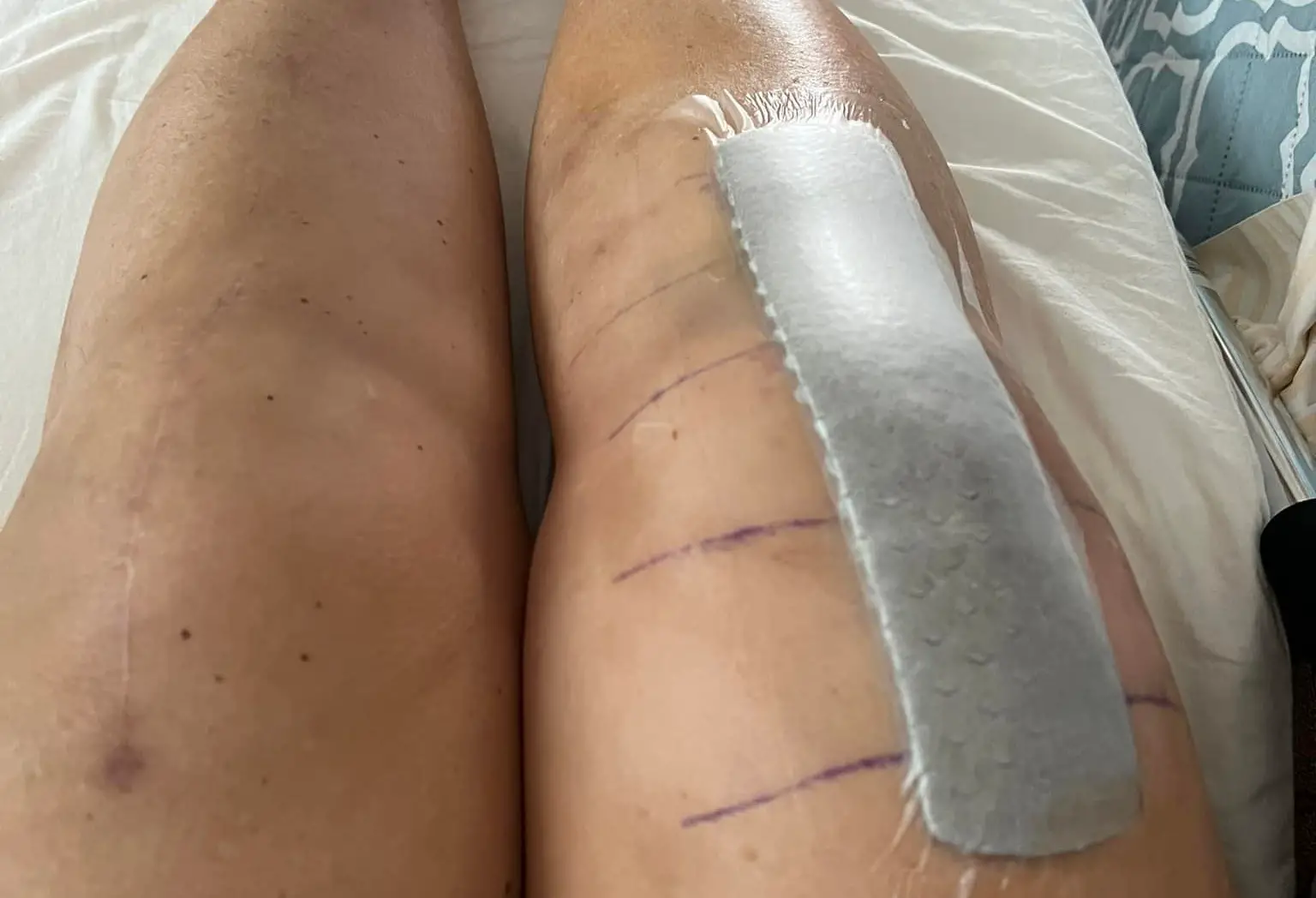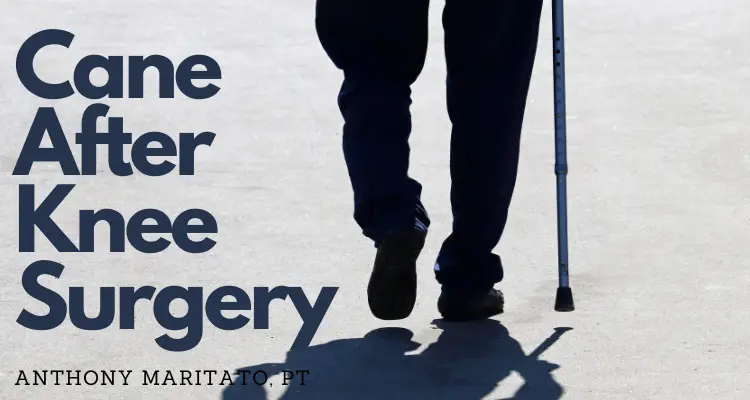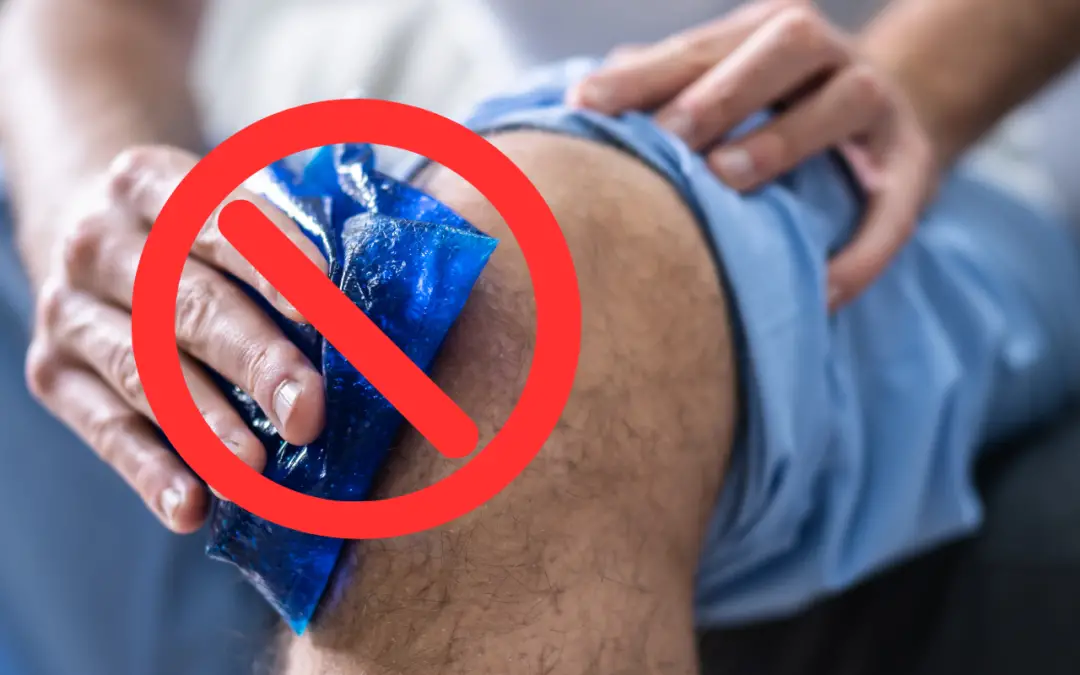Top 5 Mistakes After Knee Replacement
In this article I will share my experience as a physical therapist and personal trainer of more than 22 years treating patients after total knee replacement surgery. I have seen patients who made every mistake possible and still had a great outcome following this surgery. I have also worked with patients that have done everything right and still experienced a challenging recovery.
The greatest advantage I can provide you is access to all of that stories I have heard and the experiences I have witnessed first hand. Most of my patients have only known a handful of people that underwent a total knee replacement whereas I have likely worked with many hundres and known thousands.
Table of Contents
- 1. Overlooking Post-Surgery Medication Management
- 2. Succumbing to a Sedentary Lifestyle Instead of Embracing Guided Mobility
- 3. Overexertion: Jumping into High-Intensity Activity Too Soon
- 4. Underestimating the Role of Nutrition and Hydration in Recovery
- 5. Neglecting the Vital Role of Physical Therapy and Consistent Pain Management
Mistake #1 – Overlooking Post-Surgery Pain Management
One of the most significant barriers patients face in achieving a successful recovery after a total knee replacement surgery is the overlooking of post-surgery pain management. It’s a common situation that has more to do with fear than with negligence.
As a licensed physical therapist since 2006, I have heard countless patients report fear of addiction to narcotic pain medication as their primary reason for not complying with their doctors prescribed pain management program.
Let’s delve deeper into why proper pain management matters and how you can overcome this fear to ensure a successful knee replacement recovery.
The Role of Pain Management in Knee Replacement Recovery
- Controls Pain: Pain medications are primarily prescribed to manage post-surgical pain. This is crucial in the initial days after surgery when the pain can be intense.
- Facilitates Movement: By appropriately managing pain effectively, patients are able to move their knee joint more freely, promoting faster healing.
- Prevents Complications: Pain control can also help avoid complications like joint stiffness and muscle atrophy due to lack of movement.
The Fear of Addiction
While it’s completely natural to be wary of becoming dependent on pain medication, it’s important to understand that the risk of developing an addiction to pain medication, when taken as prescribed, is minimal.
Medical professionals prescribe these medications with careful consideration of their potential risks and benefits. Additionally, they supervise the patient’s use of these medications to prevent misuse.
The Impact of Inadequate Pain Management
The fear of addiction can inadvertently lead to poor pain management. When pain is not well-controlled, it often leads to fear of movement. In the context of knee replacement recovery, this can manifest as limited knee flexion and extension.
Reduced movement can, in turn, result in joint stiffness and hamper the overall recovery process. Consider it as a domino effect – when one tile (in this case, pain management) isn’t correctly aligned, it can knock down the rest of your recovery process.
How to Ensure Proper Medication Management
- Follow the Prescribed Dosage: Always take the medication as prescribed by your healthcare provider. Do not skip doses or stop taking the medication without your doctor’s advice.
- Communicate Openly: Keep your healthcare provider informed about your pain levels, concerns, and any side effects you experience. This helps them adjust your treatment plan if needed.
- Educate Yourself: Knowledge is power. Understand why you’ve been prescribed certain medications and how they assist in your recovery. When you know the purpose and benefits of your medications, it can alleviate fears related to them.
Remember, the goal of pain management is to make your recovery process more comfortable, thereby promoting better healing. Don’t let the fear of addiction prevent you from having a successful knee replacement recovery.
2. Succumbing to a Sedentary Lifestyle Instead of Embracing Guided Mobility
One of the common missteps that patients often make post-knee replacement surgery is falling into a sedentary lifestyle rather than embracing guided mobility. Post-surgical pain, fear of causing damage to the new joint, or simply a lack of understanding of the importance of mobility can contribute to this problem. However, lack of movement can slow down your recovery significantly.
The Role of Mobility in Knee Replacement Recovery
- Promotes Joint Health: Movement is essential for joint health. Regular, gentle movements keep the joint flexible and reduce the risk of stiffness.
- Strengthens Muscles: Regular activity strengthens the muscles around your knee, providing better support to the new joint.
- Improves Circulation: Movement improves blood circulation, bringing more oxygen and nutrients to the healing tissues, accelerating the healing process.
The Pitfalls of a Sedentary Lifestyle
Succumbing to a sedentary lifestyle after surgery can lead to a host of problems. Lack of movement can cause muscle weakness, joint stiffness, and poor blood circulation, all of which can affect your recovery negatively. It might seem counterintuitive to move after surgery, but controlled and supervised movement is a crucial part of your recovery.
Embracing Guided Mobility
While you need to move after surgery, it’s equally important that this movement is guided and controlled. Attempting to resume pre-surgery levels of activity too soon can lead to complications like persistent swelling and pain. Here’s how you can embrace guided mobility:
- Work with a Physical Therapist: A trained physical therapist can guide you on the right types and amount of activities to perform. They can help you understand the difference between discomfort due to healing and pain that might indicate a problem.
- Stick to Your Exercise Plan: Your physical therapist will create an exercise plan designed specifically for your recovery. Stick to it and make sure to perform the exercises as instructed.
- Listen to Your Body: While it’s important to push yourself to move, it’s equally important to listen to your body and not overdo it. Rest when you need to and progress at a pace that your body can handle.
In essence, movement and activity, when done right, can significantly improve your recovery after a knee replacement surgery. So, don’t let fear or uncertainty hold you back. Embrace guided mobility and take active steps towards a successful recovery.

3. Overexertion: Jumping into High-Intensity Activity Too Soon
While it’s important to start moving after a knee replacement surgery, another mistake that patients often make is attempting to resume high-intensity activities too soon. It’s understandable to be eager to get back to your normal life, but overexertion can lead to setbacks in your recovery.
The Consequences of Overexertion
- Persistent Swelling: Excessive exercise can cause swelling around the knee, limiting your mobility and delaying your physical therapy.
- Increased Pain: Overexertion can exacerbate post-surgery pain, making it harder to control.
- Delay in Recovery: Pushing yourself too hard can lead to injuries that can set your recovery back.
Navigating Exercise Post-Surgery
Resuming physical activity after knee replacement surgery is a delicate balance. Here are a few tips to help you navigate this process:
- Follow Your Therapist’s Guidelines: Your physical therapist will provide you with guidelines on when and how to resume activities. These guidelines are designed to help you gradually return to your normal activities while preventing overexertion.
- Gradual Progression: Start with low-impact activities and gradually increase the intensity as your strength and flexibility improve. Avoid high-impact activities until your therapist gives you the go-ahead.
- Listen to Your Body: Your body will give you signals when you’re overdoing it. If you notice increased pain or swelling after an activity, it might be a sign that you’re pushing yourself too hard.
Remember, recovery from a knee replacement surgery is a marathon, not a sprint. Slow and steady progress is key to a successful recovery. Overexertion might feel like a fast track to recovery, but it often leads to setbacks. So, take it easy and give your body the time it needs to heal.

4. Underestimating the Role of Nutrition and Hydration in Recovery
Often, patients are so focused on their physical recovery that they forget about the crucial role nutrition and hydration play in their post-surgery healing journey. Adequate nutrition provides your body with the energy and resources it needs to repair tissues and recover, while proper hydration helps flush out anesthetic medications and maintain healthy blood pressure.
The Impact of Poor Nutrition and Hydration
- Delayed Wound Healing: Lack of proper nutrients can slow down the healing process of surgical wounds.
- Increased Risk of Infection: Poor nutrition can weaken your immune system, increasing the risk of infection post-surgery.
- Dehydration: Inadequate hydration can lead to a range of health issues from mild fatigue to severe complications like kidney stones or blood clots.
How to Optimize Your Nutrition and Hydration Post-Surgery
Here are some key strategies to improve your nutrition and hydration during your recovery:
- Focus on Protein: Proteins are the building blocks of tissue. Ensure your diet includes sufficient protein to support wound healing and recovery.
- Include Fruits and Vegetables: They are rich in antioxidants that can help combat inflammation, promoting faster healing.
- Avoid Sugary Foods: Sugar can lead to inflammation which may hamper your recovery. Opt for natural sweeteners like fruits.
- Stay Hydrated: Make sure to drink plenty of fluids throughout the day. This helps in flushing out toxins and maintaining a healthy metabolism.
- Limit Alcohol: Alcohol can interact with your medications and also lead to dehydration. It’s best to limit your intake during your recovery.
Your diet post-surgery plays a significant role in how quickly and smoothly you recover. A well-balanced diet rich in vital nutrients combined with proper hydration can significantly enhance your healing process and get you back on your feet sooner.

5. Neglecting the Vital Role of Physical Therapy and Consistent Pain Management
There’s no denying the fact that post-surgery recovery, especially from a total knee replacement surgery, is a demanding process, both physically and mentally. However, neglecting physical therapy or being inconsistent with pain management can lead to suboptimal recovery outcomes and may prolong the recovery period significantly.
The Consequences of Neglecting Physical Therapy
- Reduced Joint Mobility: Not adhering to your physical therapy regimen can result in decreased range of motion and joint stiffness.
- Delayed Recovery: Regular and consistent physical therapy sessions are essential for a speedy recovery. Skipping these sessions can delay healing and return to normal activities.
- Increased Risk of Complications: Postoperative exercises are designed to strengthen your muscles and enhance your balance and coordination, thus reducing the risk of falls and other complications.
How to Effectively Integrate Physical Therapy and Pain Management
- Follow Your Therapist’s Instructions: Your therapist has designed a regimen tailored specifically to your needs. Adherence to this program is crucial for optimal recovery.
- Practice Pain Management: Use prescribed pain medications as instructed to manage discomfort and facilitate physical therapy. Remember, pain management is more effective when done consistently.
- Ask Questions: Don’t hesitate to clarify any doubts about your exercise regimen with your therapist. Understanding why and how to perform exercises can help motivate you to stay consistent.
- Listen to Your Body: While it’s important to push your limits during therapy, don’t overdo it. If something feels wrong, take a break and inform your therapist.
It’s important to remember that a successful recovery from a total knee replacement surgery is a joint effort. Your commitment to consistent physical therapy and effective pain management is just as critical as the surgical procedure itself. Remember, your long-term mobility and overall health are worth the time and effort.

Summary and Key Takeaways
Navigating post-surgery recovery, particularly after total knee replacement surgery, can be challenging but understanding and avoiding common mistakes can make a significant difference in the healing process. Successful recovery demands a comprehensive approach that goes beyond the operating room. It involves proper medication management to mitigate pain, embracing guided mobility instead of succumbing to a sedentary lifestyle, ensuring a balanced diet and adequate hydration for optimal healing, and engaging consistently in physical therapy. It’s also crucial to avoid overexertion by not resuming high-intensity activities too early.
Through this article, we’ve discussed these aspects in detail, providing practical tips to help patients avoid these pitfalls. The key takeaway is that a successful recovery requires active participation from the patient: adherence to prescribed medication, maintaining a balance between rest and exercise, nourishing the body adequately, and committing to a comprehensive physical therapy regime. Moreover, it’s important to listen to your body, be patient with your progress, and always communicate with your healthcare providers should any concerns arise. Armed with this knowledge, patients can facilitate a smoother recovery journey, accelerating their return to normal activity and enhancing their overall quality of life.

Anthony Maritato, PT
Physical Therapist
Anthony Maritato, PT has been a licensed physical therapist and private practice owner since 2006. Ohio license #PT011602.
Anthony has been passionate about helping patients recover from total knee replacement surgery as well as rotator cuff repair surgery.

RENPHO Active Thermacool 2 Massage Gun with Heat and Cold Therapy

Managing Pain After Total Knee Replacement
Introduction to Managing Pain After a Knee Replacement Undergoing a total knee replacement is a significant medical procedure that can dramatically improve your quality of life. However, the journey to full recovery involves navigating through various challenges, one...

Total Knee Replacement Pain at Night
What to Expect Explore our comprehensive guide on managing 'Total Knee Replacement Pain at Night.' Learn about the causes of night pain, effective pain management strategies, best sleeping positions, and more. This article provides practical advice to help individuals...

Overview of Spinal Stenosis
Table of Contents What is spinal stenosis What are the symptoms of spinal stenosis How is spinal stenosis diagnosed What are the different types of treatment for spinal stenosis Where to find more information 1. What is spinal stenosis Spinal stenosis is a condition...

Spinal Stenosis Exercises to Avoid: During Knee Replacement Recovery
Spinal stenosis is relatively common among adults having a total knee replacement surgery. While spinal stenosis doesn't always impact total knee replacement recovery, when it does, it can be frustrating. Before I specialized in treating patients after a total knee...

Ride a Peloton After Knee Replacement Surgery
Table of Contents When can I return to riding my Peloton bike at home after a total knee replacement? Is a Peloton bike good physical therapy after a total knee replacement surgery? Will riding my Peloton too much wear out my new knee? How often should I ride my...

How to Use a Cane After Knee Surgery
Table of Contents Understanding the Purpose of Using a Cane after Knee Surgery How to Properly Use a Cane after Knee Surgery Common Mistakes to Avoid When Using a Cane Transitioning from a Walker to a Cane: When and How? Understanding the Purpose of Using a Cane after...

Ice Machine for Knee Surgery
Table of Contents Benefits of Using an Ice Machine After Knee Surgery How an Ice Machine Works Top Ice Machines for Knee Surgery Recovery How to Use an Ice Machine After Knee Surgery Where to Buy an Ice Machine and What to Consider Benefits of Using an Ice Machine...

Walking Your Dog After Knee Replacement Surgery: A Timeline for Recovery
Table of Contents Introduction Walking Your Dog After Knee Replacement Safety Considerations and Precautions Conclusion Introduction Hello, fellow dog lovers and knee replacement warriors! I'm Anthony Maritato, a licensed physical therapist specializing in post-total...

Disadvantages of Knee Replacement Surgery
Table of Contents Introduction Pain Time Lost Cost Stress Post Surgical Risk or Complications Conclusion Introduction When considering treatment options for severe knee arthritis, one commonly considered intervention is knee replacement surgery. Despite its high...